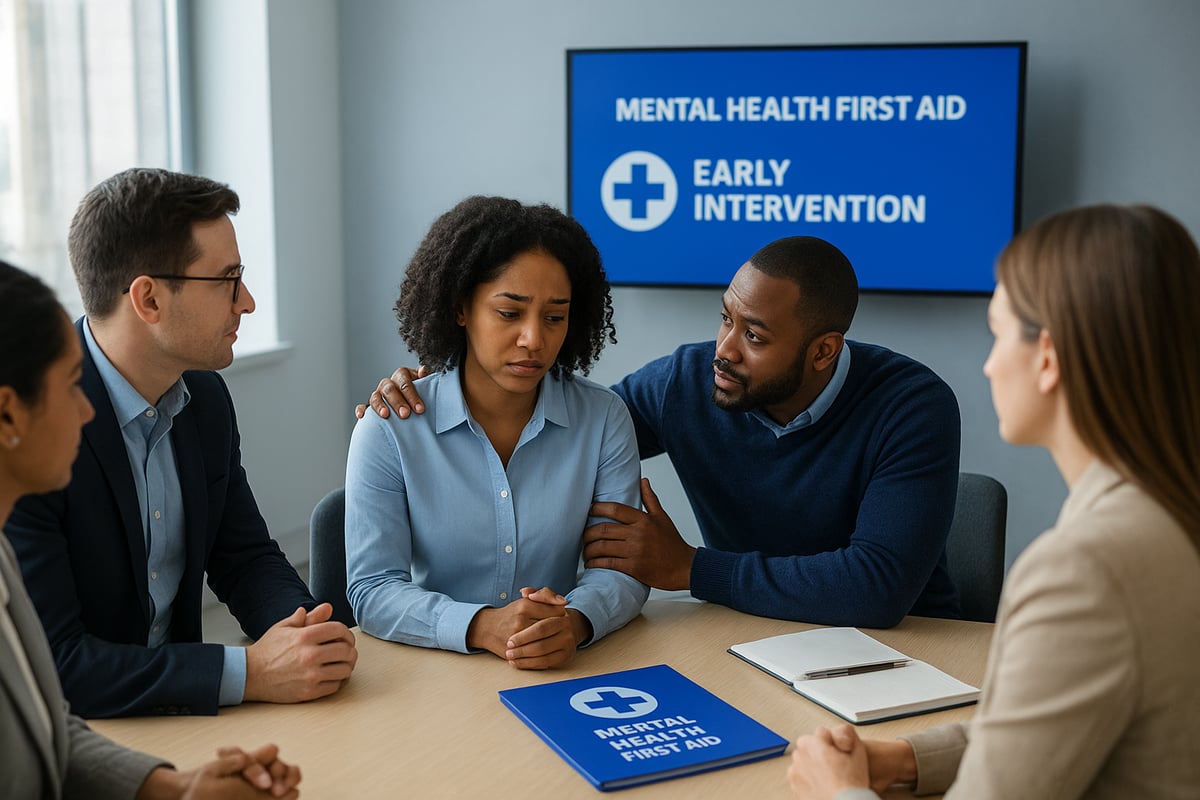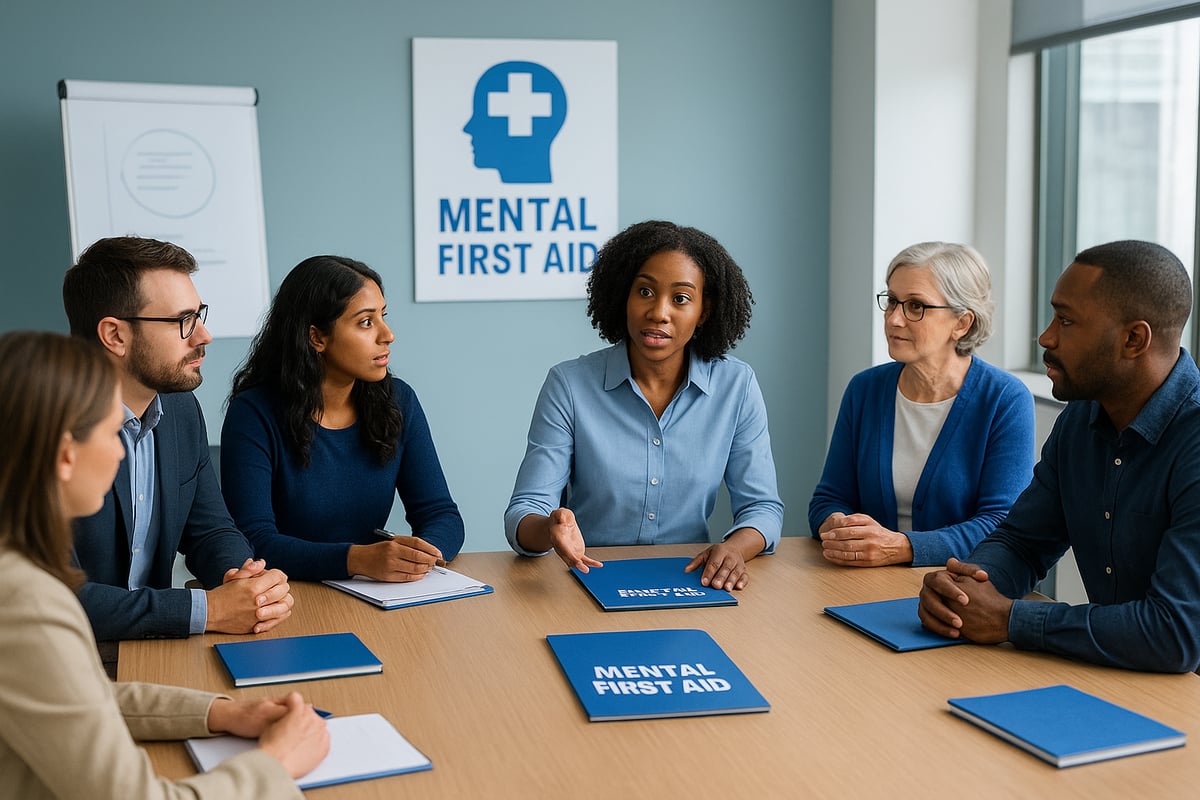Did you know that by 2025, mental health challenges will impact nearly one in four people worldwide? As awareness grows, the demand for mental first aid training becomes urgent for both individuals and organizations. This essential guide offers a practical, in-depth look at mental first aid training, covering the latest standards, proven strategies, and actionable steps for 2025. Discover what mental first aid is, why it matters more than ever, and how the right training can transform wellbeing. Ready to make a difference? Start your journey to effective support and resilience now.
Understanding Mental First Aid: What It Is and Why It Matters
Defining Mental First Aid
Mental first aid is an essential practice focused on recognizing and responding to early signs of mental health challenges. Unlike traditional first aid, which addresses physical injuries, this approach emphasizes providing timely support for emotional or psychological distress. The core of mental first aid training is early intervention, offering reassurance, and reducing the stigma around mental health conversations.
A simple, empathetic conversation can change the course of someone's struggle. For example, noticing a colleague's withdrawal and reaching out with care may prevent a crisis. By learning the basics of what is mental health first aid, individuals gain the confidence to support others before professional help arrives.
The Growing Need in 2025
In 2025, the demand for mental first aid training is higher than ever. According to the World Health Organization, one in four people will experience a mental health issue during their lifetime. The lingering effects of the COVID-19 pandemic, ongoing economic uncertainty, and social pressures have amplified stress in both workplaces and communities.
Organizations are seeing a rise in mental health incidents, creating an urgent need for trained responders. As awareness grows, so does the expectation for individuals and leaders to be prepared. Mental first aid training is becoming a critical skill set for navigating modern life and its challenges.
Benefits of Mental First Aid Training
There are significant benefits to mental first aid training, both for individuals and organizations. Key advantages include:
- Better recognition of mental health warning signs.
- Increased confidence in offering immediate support and appropriate referrals.
- Lower rates of absenteeism and improved team wellbeing.
For instance, a workplace that implemented mental first aid training saw psychological injury claims drop by 50 percent. This demonstrates how practical, evidence-based training can create safer, more supportive environments for everyone.
Who Needs Mental First Aid Training?
Mental first aid training is valuable for a wide range of people. Target audiences include managers, HR professionals, educators, employees, community leaders, and parents. Each group has a unique role in fostering wellbeing and resilience.
In workplaces, legal and ethical duties of care are driving the adoption of mental first aid training programs. Beyond compliance, these skills help build resilient communities by empowering individuals to act with empathy and confidence when it matters most.

Key Components and Latest Standards in Mental First Aid Training 2025
The landscape of mental first aid training continues to evolve. In 2025, new standards, skills, and delivery methods ensure that individuals and organizations are better equipped to respond to mental health needs. Understanding these key components is crucial for anyone looking to provide effective support or implement training at scale.

Core Principles and Skills
At the heart of mental first aid training are essential principles that guide effective intervention. Active listening, empathy, and non-judgmental support form the foundation. Trainees learn how to maintain confidentiality and assess crisis situations calmly.
A typical approach includes four steps: assess the situation, listen without judgment, give reassurance, and encourage professional help. These skills empower people to respond promptly and appropriately. For example, recognizing subtle changes in behavior and initiating a supportive conversation can prevent escalation.
Mastering these basics in mental first aid training ensures everyone can play a role in fostering a safer, more supportive environment.
Updated Guidelines and Accreditation
In 2025, leading organizations have updated mental first aid training standards to reflect current research and societal needs. Certification now requires a blend of core knowledge, practical skills, and ongoing education. Recertification cycles are shorter to keep pace with emerging best practices.
Key updates include trauma-informed care and cultural sensitivity as required competencies. Programs must align with recognized frameworks to ensure quality and consistency. For those seeking official credentials, the Accredited Mental Health First Aid Certification provides a comprehensive overview of current requirements and standards.
Staying accredited demonstrates a commitment to safe, effective mental health support.
Evidence-Based Approaches
Mental first aid training in 2025 is grounded in evidence-based practices. Programs incorporate proven methods, such as the basics of Cognitive Behavioral Therapy (CBT), to enhance intervention effectiveness.
Research consistently shows that evidence-based mental first aid training leads to significant improvements. For instance, some programs report up to a 79 percent reduction in mental health problems among participants. This focus on science-backed approaches builds confidence and ensures positive outcomes.
By emphasizing research and measurable results, mental first aid training delivers real-world impact.
Integration with Workplace Policies
Embedding mental first aid training into organizational policies is now considered best practice. Companies integrate training into HR and wellbeing strategies to meet legal and ethical responsibilities, such as those outlined in ISO 45003 for psychosocial safety.
Effective integration leads to measurable benefits, including reduced absenteeism and improved team morale. For example, organizations that prioritize mental first aid training have achieved up to a 33 percent decrease in workplace absences related to mental health.
Aligning training with workplace policies ensures a culture of care and compliance.
Digital and Hybrid Training Options
Digital transformation has reshaped mental first aid training delivery. In 2025, virtual and hybrid formats are widely available, making training more accessible and scalable for diverse audiences.
Online modules offer flexibility and cost-effectiveness, while blended options combine digital learning with in-person practice. Studies show that digital mental first aid training can achieve outcomes comparable to traditional classroom formats.
This evolution allows organizations and individuals to access mental first aid training that fits their unique needs and schedules.
Step-by-Step Guide: How to Become a Certified Mental First Aider in 2025
Becoming certified in mental first aid training in 2025 is a structured journey designed to empower individuals and organizations with the skills to recognize and respond to mental health challenges. This guide leads you through every stage, from initial assessment to ongoing skill development.

Step 1: Assess Your Needs and Goals
Start your mental first aid training journey by clarifying your personal or organizational objectives. Are you aiming to support colleagues, students, or community members?
Identify if you need basic, advanced, or refresher mental first aid training. For example, an HR manager may require advanced skills to handle workplace crises, while a general employee might benefit from foundational knowledge.
Consider these questions:
- What mental health challenges are most relevant to your environment?
- Are there legal or policy requirements for training?
- Do you want to specialize, such as focusing on youth or trauma?
This initial assessment ensures you select the right training and maximize your impact.
Step 2: Research Accredited Training Providers
Selecting a reputable mental first aid training provider is crucial for effective learning. Seek programs with recognized accreditation, qualified trainers, and an evidence-based curriculum.
Key criteria to consider:
- Is the program accredited by a national or international body?
- Are trainers experienced professionals in mental health?
- Does the curriculum reflect the latest research and standards?
- What are participant outcomes or satisfaction rates?
You can consult Mental Health First Aid Impact Statistics to review program effectiveness and reach. Avoid providers with outdated materials or without valid certification.
Step 3: Enroll and Prepare for Training
Once you’ve chosen your mental first aid training provider, complete the registration process. Some courses may require prerequisites, such as basic mental health awareness.
Preparation tips:
- Review any pre-reading materials or self-assessment tools.
- Set aside dedicated time for learning.
- Decide if an online, in-person, or hybrid format best fits your schedule.
For example, online training offers flexibility, while in-person sessions may provide richer group discussions. Preparation sets the stage for active participation and knowledge retention.
Step 4: Complete the Training Modules
Mental first aid training typically combines theory, practical scenarios, and group discussions. You’ll learn to recognize mental health warning signs, respond to crises, and practice self-care.
Common module components:
- Theoretical foundations of mental health and first aid
- Interactive role-plays and real-world scenario walkthroughs
- Group discussions and peer feedback
Assessment methods may include quizzes, simulations, and practical demonstrations. For instance, you might practice responding to a colleague showing signs of distress in a role-play setting. Throughout the modules, mental first aid training emphasizes application, not just theory, ensuring you’re ready to support others.
Step 5: Pass the Certification Assessment
After completing the curriculum, you’ll need to pass a certification assessment. This may include written tests, practical demonstrations, or online evaluations.
To succeed:
- Review all guidelines and key concepts
- Practice with sample scenarios or quizzes
- Ask your trainer for feedback on areas needing improvement
Certification is typically valid for a set period, often two to three years, after which renewal is required. Passing the assessment confirms your readiness to provide mental first aid training support.
Step 6: Apply Skills in Real Life
With certification, you can actively use your mental first aid training to support colleagues, friends, or family. Early intervention is key to preventing escalation and promoting recovery.
Best practices include:
- Listening non-judgmentally and offering reassurance
- Documenting incidents appropriately
- Referring individuals to professional help when needed
For example, if a coworker displays signs of anxiety, you can provide support and guide them toward resources. Applying your skills builds trust and resilience in your community.
Step 7: Maintain and Update Your Skills
Ongoing education is essential for maintaining your mental first aid training effectiveness. Participate in annual refresher courses to stay updated on new research and evolving best practices.
Consider advanced training or specialization in areas like trauma or youth mental health. Engage with professional communities, attend webinars, and review updated guidelines regularly.
A commitment to continuous learning ensures your mental first aid training remains relevant and impactful. For instance, individuals who complete annual refreshers often report greater confidence and improved outcomes in real-life interventions.
Real-World Applications: Mental First Aid in Action
Every day, the impact of mental first aid training is visible across workplaces, schools, and communities. By equipping individuals with practical skills, mental first aid training transforms how organizations and individuals respond to mental health challenges. Let us explore how these skills make a difference in real-world situations.

Workplace Scenarios
Mental health challenges such as stress, burnout, and interpersonal conflict are common in today’s workplaces. Employees trained in mental first aid training can recognize early warning signs and step in before issues escalate. For example, a trained team member might notice a colleague withdrawing and initiate a private, supportive conversation. This proactive approach can de-escalate a crisis and encourage help-seeking.
Organizations that integrate mental first aid training into their wellbeing strategies see significant improvements. According to Building Psychological Safety at Work, fostering a culture of psychological safety enables employees to speak up, seek support, and address challenges early. This approach leads to fewer absences, reduced turnover, and a more resilient workforce.
Schools and Educational Settings
In schools, mental first aid training empowers teachers and staff to recognize and respond to signs of distress in students. These skills are vital for early identification and intervention, especially as youth face increasing pressures. For example, a teacher trained in mental first aid training may notice behavioral changes in a student and initiate a supportive discussion, connecting them with school counselors if needed.
Timely intervention can prevent self-harm or further mental health deterioration. Schools with regular mental first aid training report improved student wellbeing and a safer, more inclusive environment. Early support also helps reduce stigma, making it easier for students to ask for help when they need it.
Community and Public Settings
Mental first aid training is not limited to formal organizations; it plays an essential role in community centers, public spaces, and volunteer groups. Trained individuals can assist strangers or vulnerable populations experiencing distress. For example, a volunteer at a community event may spot someone in crisis and use their mental first aid training to offer reassurance, listen non-judgmentally, and connect them with local resources.
These actions help build more compassionate, supportive communities. By spreading awareness and skills through mental first aid training, communities can respond effectively to emergencies, reduce isolation, and promote recovery for those affected by mental health issues.
Impact and Measurable Outcomes
The measurable impact of mental first aid training is well documented. Programs consistently show reduced stigma, increased willingness to seek help, and improved overall wellbeing. For instance, research shows that 96 percent of participants report greater confidence in supporting others after completing mental first aid training.
A recent case study found that community-wide adoption of mental first aid training led to a significant rise in help-seeking and a decrease in crisis incidents. According to Research on Mental Health First Aid Effectiveness, these programs also enhance mental health literacy and foster a culture of support. The ripple effects extend from individuals to entire organizations and communities, creating lasting change.
Choosing the Right Mental First Aid Training Program
Selecting the best mental first aid training program is a critical step for individuals and organizations aiming to foster a culture of mental wellbeing. With so many options available, it is essential to focus on quality, evidence-based curriculum, and practical outcomes. The right choice ensures your investment leads to real and lasting improvements.
Key Selection Criteria
When evaluating mental first aid training programs, prioritize those with recognized accreditation and proven, evidence-based content. Qualified instructors should have relevant credentials and real-world experience in mental health. Flexibility is important, so look for options that offer in-person, online, or hybrid formats to suit different learning needs.
Consider cost, accessibility, and the availability of ongoing support after initial certification. Programs that provide regular updates, refresher courses, and community forums can make a significant difference. Selecting a program aligned with your organizational values and goals ensures the mental first aid training has a lasting impact.
Comparing Leading Providers
Top mental first aid training providers differ in approach, delivery, and specialty. Some focus on workplace resilience, while others excel in trauma-informed care or youth mental health. Use data and independent research to inform your choice. For example, the Mental Health First Aid Research Infographic summarizes outcomes like improved confidence and increased help-seeking.
| Provider | Format | Specialty | Accreditation | Notable Outcome |
|---|---|---|---|---|
| WMHI | Hybrid | Workplace, resilience | Yes | 57% wellbeing gain |
| MHFA International | In-person | General population | Yes | High satisfaction |
| National Youth Program | Online | Youth mental health | Yes | Youth engagement |
Compare these features to match your mental first aid training goals.
Workplace Mental Health Institute: Comprehensive Mental Health Training Solutions
The Workplace Mental Health Institute (WMHI) delivers evidence-based mental first aid training designed for real-world application. WMHI offers tailored programs for managers and employees, with a practical focus on resilience, crisis response, and ongoing support. Their global reach and flexibility in delivery make them a strong choice for organizations of all sizes.
Participants report a 57% improvement in workplace wellbeing after completing WMHI programs. Training is led by qualified professionals and includes access to resources for continued learning. This approach ensures mental first aid training is not just a checkbox but a catalyst for genuine culture change.
Questions to Ask Before Enrolling
Before enrolling in any mental first aid training, ask these critical questions to determine program suitability:
- What are the trainer’s qualifications and experience?
- How is the training delivered and assessed?
- Is the curriculum current and evidence-based?
- Are ongoing resources and community support available?
- Does the program meet specific legal or organizational requirements?
A simple checklist can help:
[ ] Accredited provider
[ ] Qualified instructors
[ ] Flexible delivery format
[ ] Evidence-based content
[ ] Ongoing support/resources
Taking these steps ensures your mental first aid training investment delivers measurable, sustainable benefits.
As we’ve explored, equipping yourself or your team with mental first aid skills in 2025 isn’t just proactive—it’s essential for building a healthier, more resilient workplace. Whether you’re looking to foster early intervention, reduce absenteeism, or create a supportive environment, understanding the latest training standards and practical approaches can make a real difference. If you’re ready to take the next step and discover tailored programs that fit your organization’s unique needs, you can Find Out More about how to get started and make a measurable impact on wellbeing.


